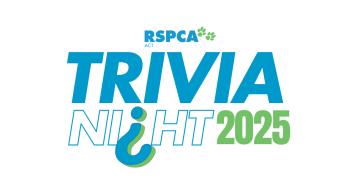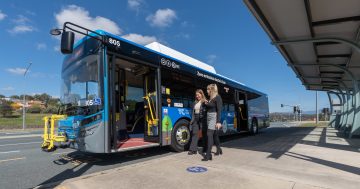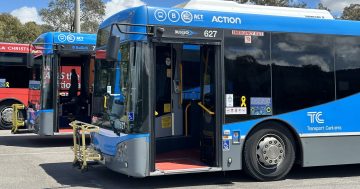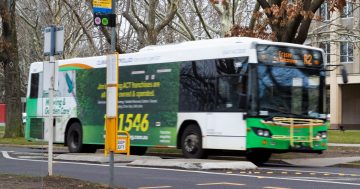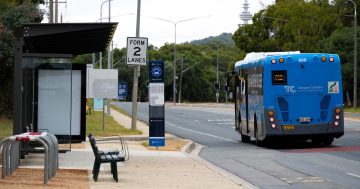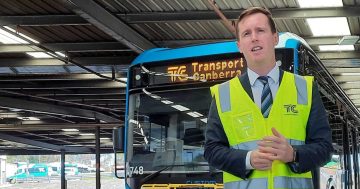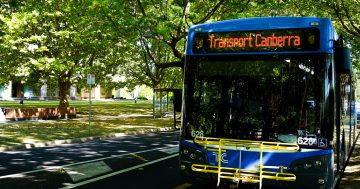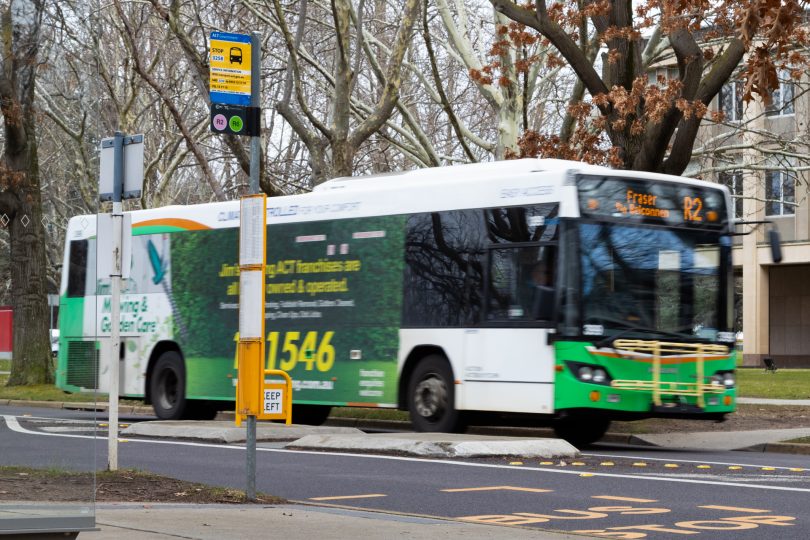
The interim bus timetable is an inferior service, according to the PTCBR. Photo: Michelle Kroll.
Canberra’s public transport lobby has called for the reinstatement of the regular bus timetable, saying COVID-19 appears to receding and many staff are returning to their offices.
Public Transport Association of Canberra (PTCBR) says Canberrans are right to be worried that the “new normal” might include inferior bus services.
The ACT Government implemented an interim bus timetable last August in response to the Delta outbreak which put many bus drivers in quarantine, and has extended it twice – the latest from 31 January to deal with the Omicron wave.
To manage driver shortages and ensure a reliable service, the interim timetable reduced peak frequencies to every 30 minutes for local routes, down from every 15 or 20 minutes, with other reductions on the rapid routes.
But PTCBR says the government has given no firm indication when buses might return to normal service.
PTCBR Chair Ryan Hemsley says that with weekday passengers now approaching the levels they were in August 2021, the ACT is not getting the bus service it needs, nor the one the government promised.
“Frequent services are the key to any successful public transport system,” he said. “Under the interim timetable, we’ve got people waiting around at interchanges for up to half an hour, and then squeezing into crowded buses. If we want people to get off the roads and back onto public transport, we need the regular timetable.”
PTCBR’s review of Transport Canberra data shows that for the week ending 4 March 2022, there were an average of 55,406 weekday boardings, which is close to the August 2021 figures of around 65,000.
Boardings on local routes, which have been most affected by the reduced timetable, are also now approaching pre-pandemic levels. On 4 March 2022, there were 27,602 boardings, compared to 28,915 boardings on 28 February 2020.
Mr Hemsley blamed the situation on staffing issues that have plagued Transport Canberra for many years.
“This is the same problem which led to the unacceptable reduction in weekend services,” he said.
“This government has an exciting transport vision, and is willing to fund it. But this is meaningless unless it can get drivers for the services Canberra needs.
“We’ve seen claims that it’s because of industrial issues, because of recruitment difficulties, because of COVID. Frankly, whatever the cause, it’s been three years now, and it’s the government’s responsibility to sort out. We need a bus workforce that is sufficiently resilient to handle a few unexpected absences.”
A government spokesperson said Transport Canberra was working towards restoring the normal timetable in Term 2 but it would depend on workforce availability, the health situation and advice.
“The ACT Government continues to be guided by the health advice when making decisions associated with resourcing risks and customer safety impacting the reliability of the service delivery,” the spokesperson said.
“The interim bus timetable allows contingency and assists in managing staff shortages as a result of COVID-19. It also ensures service reliability across the network for Canberrans who need it.”
Transport Minister Chris Steel told a committee hearing last Friday that Transport Canberra was taking a conservative approach to managing the timetable to ensure reliability.
He said a return to the regular timetable would not occur until the health settings were right and Transport Canberra was confident that the pandemic was not impacting the numbers of drivers available to work as much as it is now.
“My priority is reliability because even though there is a slightly reduced level of service in terms of frequency on some of the routes – we still have high capacity and frequency particularly on the Rapid routes for example – and still the same level of service on the weekend, reliability has to be there because if people are going to wait for a service they need to know it actually arrives,” he said.
“That will always be my priority in the system because it builds confidence in the system and the worst thing that could happen is if we go back up to the previous level of service delivery and we cannot deliver those services.
“That would be the worst possible outcome and that’s why we’ve taken this approach.”
Executive Branch Officer, Bus Operations, Ian McGlinn said the interim timetable gave Transport Canberra the capacity to manage day to day absences.
“You can borrow and scrape and get people to do extra shifts but you can’t continually do that,” he told the committee.
The government is also considering a new campaign to attract people back to public transport that would focus on re-education and raising awareness of new offerings in the system.
The hearing was told that patronage, while recovering, was still only at 60 per cent of pre-COVID levels.
The interim timetable allows for all local services and the Rapid 10 to run at least every 30 minutes and all other Rapids to run at least every 15 minutes during the day and around every hour after 8pm during the week.
This includes 233 dedicated school services trips.
The government says that it is continuing to monitor public transport patterns, reliability and staffing availability as the COVID situation progressively eases, and will reinstate the full timetable at the earliest and safest opportunity.











